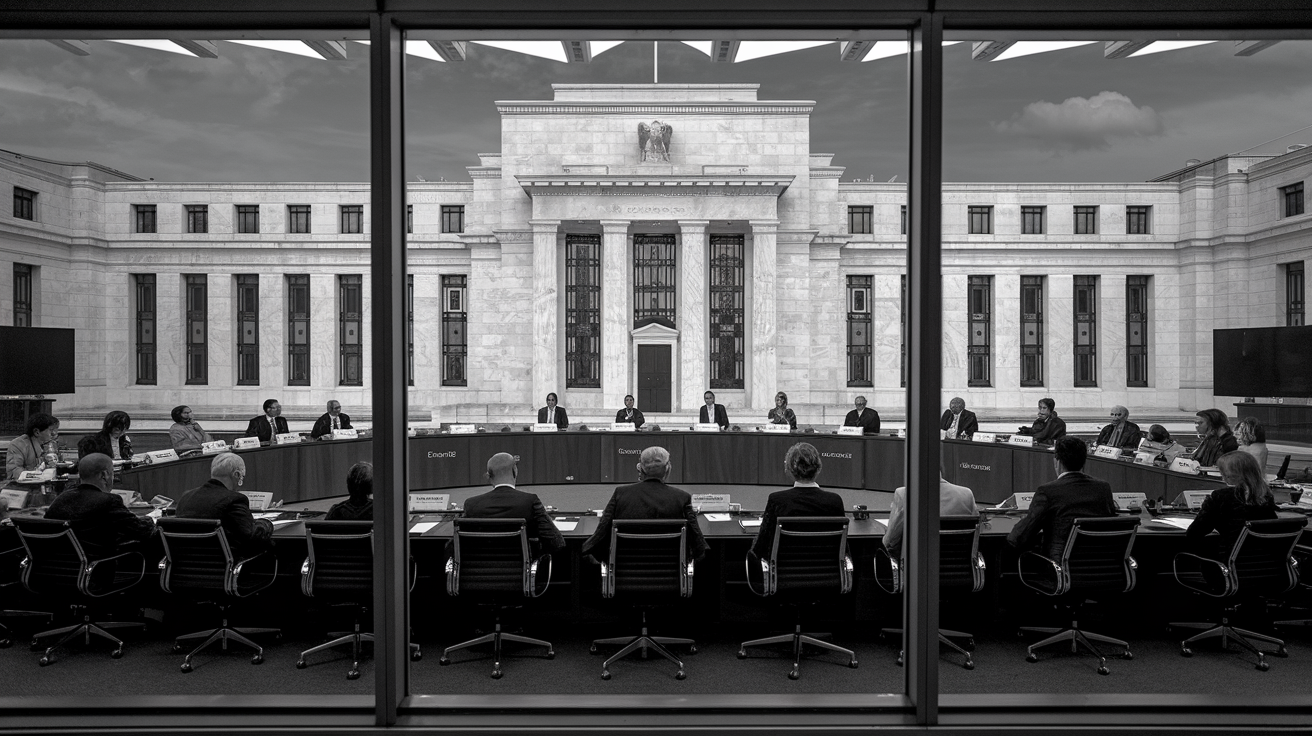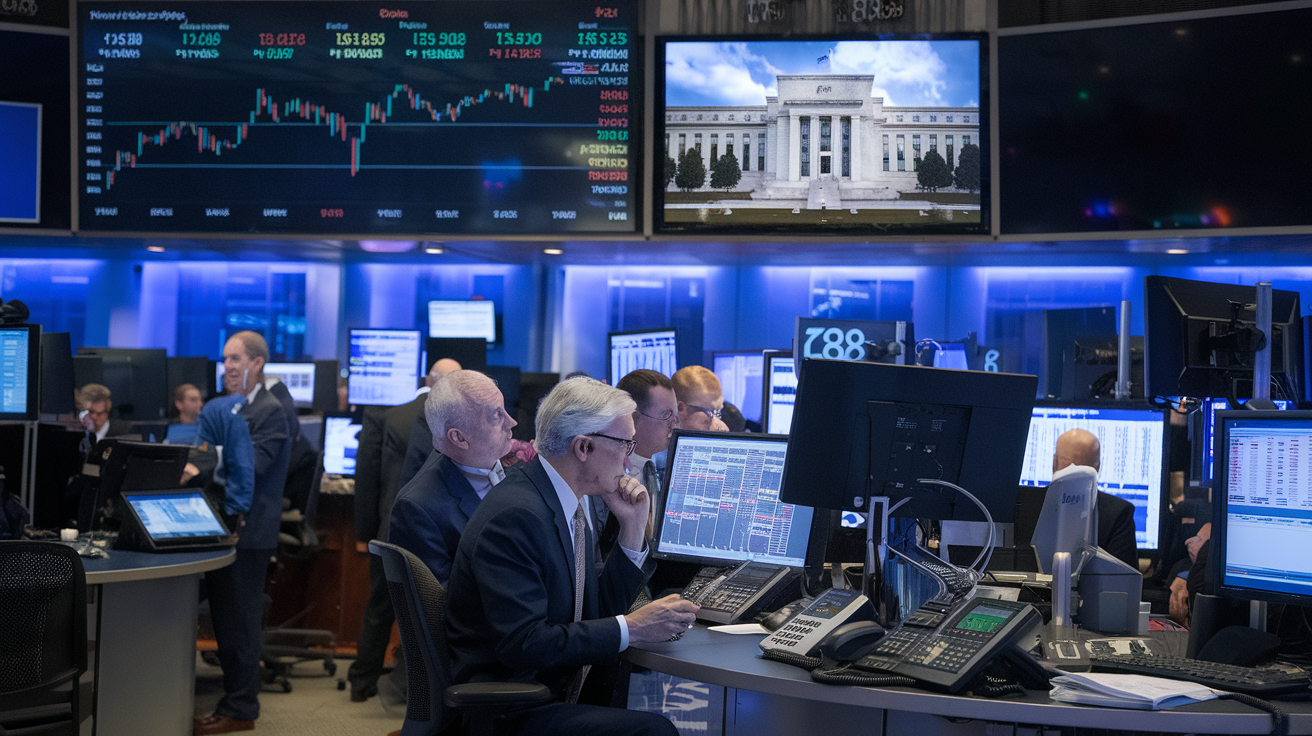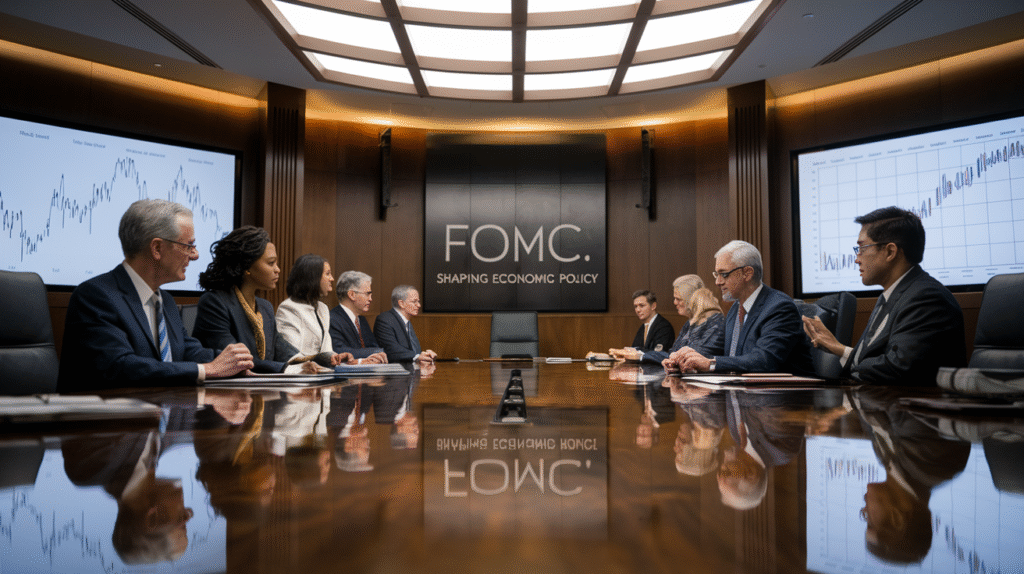Have you ever noticed how markets hold their breath before the Fed speaks? That’s not dramatic—it’s reality. The S&P 500 swings an average of 0.6% on FOMC meeting days alone.
Ever wonder what actually happens behind those closed Federal Reserve doors? You’re not alone.
This guide breaks down FOMC meetings in plain English – what they are, why they matter to your money, and how to interpret all the financial jargon that follows. Understanding Federal Reserve meetings doesn’t require an economics degree, just the right translation.
The fascinating part? The Fed actually tells us what they’re planning to do with interest rates. You just need to know where to look.
The Basics of FOMC: Demystifying the Federal Reserve’s Key Committee

Who sits on the FOMC and how they’re selected
Ever wonder who’s actually pulling the economic levers? The Federal Open Market Committee (FOMC) consists of 12 voting members. The core seven are the Federal Reserve Board of Governors – all presidential appointees confirmed by the Senate for 14-year terms. The Fed Chair (currently Jerome Powell) heads both the Board and the FOMC.
The remaining five voting seats rotate among the 12 regional Federal Reserve Bank presidents, except for the New York Fed president who’s always a voting member due to New York’s role in executing monetary policy operations.
This mix ensures both Washington’s perspective and regional economic insights shape our monetary policy.
The dual mandate: Understanding the FOMC’s core responsibilities
The FOMC isn’t just messing with interest rates for fun. Congress gave them two specific jobs: maximize employment and keep prices stable.
This “dual mandate” means they’re constantly balancing two goals. They want as many Americans working as possible while keeping inflation around their 2% target. When unemployment rises, they might lower rates to stimulate growth. When inflation heats up, they might raise rates to cool things down.
It’s basically economic tightrope walking.
How often the FOMC meets and why these dates matter to investors
The FOMC gathers eight times annually on a predetermined schedule – about every six weeks. These aren’t casual coffee meetings. Each session runs two days with the policy announcement coming on day two, typically at 2:00 PM Eastern.
Smart investors mark these dates on their calendars because FOMC decisions instantly impact everything from mortgage rates to stock prices. Markets often become volatile around these announcements.
The Committee also releases detailed meeting minutes three weeks later, giving investors deeper insight into their thinking and future plans. Miss these dates at your portfolio’s peril.
The Impact of FOMC Decisions on Financial Markets

Interest rate adjustments and their ripple effects
When the FOMC tweaks interest rates, it’s like dropping a stone in a pond. The ripples touch everything in our financial lives.
Higher rates make borrowing more expensive. Mortgage rates climb, credit card interest jumps, and auto loans cost more. Businesses think twice about expanding or hiring when money gets pricier.
On the flip side, savers finally catch a break when rates rise. Your bank accounts and CDs might actually pay something worth mentioning.
The stock market? It’s complicated. Rate hikes typically push stocks down initially as future earnings get discounted more heavily. But the market often rebounds if it sees the Fed fighting inflation effectively.
How FOMC statements move markets in real-time
The markets hang on every word from the Fed. Literally every. Single. Word.
Traders parse these statements with almost religious devotion, and markets can swing wildly within minutes of release. A single phrase change from “patient” to “vigilant” can send stocks soaring or plunging.
Take March 2020 – when the Fed announced emergency measures during COVID, the S&P 500 jumped 6% in minutes. That’s trillions in market value from one announcement.
Interpreting the “dot plot” forecast
The dot plot isn’t just a bunch of dots on a chart. It’s the financial equivalent of a crystal ball.
Each dot represents a Fed member’s projection for where interest rates should be at various points in the future. When those dots shift higher, markets brace for tighter policy. When they drift lower, investors celebrate easier money ahead.
The trick is looking at the pattern, not just the median. Clusters show consensus, scattered dots reveal uncertainty.
Historical market reactions to policy shifts
History tells us a lot about how markets might respond to Fed moves:
| Policy Action | Typical Stock Market Reaction | Bond Market Response |
|---|---|---|
| Surprise Rate Cut | Sharp rally (+2-5%) | Yields fall dramatically |
| Expected Rate Hike | Slight dip then recovery | Minimal movement |
| Hawkish Language | Initial sell-off (-1-3%) | Yields rise |
| QE Announcement | Strong rally | Long-term yields fall |
The 2018 December rate hike triggered a 20% market correction when investors thought the Fed was ignoring economic warning signs. In contrast, the “Fed pivot” hints in late 2022 sparked a significant rally.
Smart investors watch not just what the Fed does, but how it differs from what was expected.
Reading Between the Lines: Decoding FOMC Communications

A. How can I find the FOMC meeting schedule?
The Federal Reserve Board’s official website has the schedule of FOMC meetings. Schedules of Board Meetings by Year are available. Calendars and information about FOMC meetings are also released by the Federal Reserve Board.
The Federal Open Market Committee, or FOMC, meets eight times a year on a regular basis. The FOMC’s next meeting is scheduled for May 6-7, 2025. Meetings in January, March, May, June, July, September, October, and December are scheduled for 2025, while January, March, April, June, July, September, and October are scheduled for 2026.
B. Key terminology that signals policy direction
Ever watched the markets swing wildly after an FOMC statement drops? That’s because traders are hunting for specific buzzwords. Terms like “patient,” “gradual,” “accommodative,” and “extended period” aren’t just filler—they’re deliberate signals.
When the Fed mentions “vigilant against inflation,” they’re putting on their hawk costume. If they talk about “risks to economic activity,” they’re slipping into dove feathers. The shift from “gradual increases” to “patience” in early 2019 wasn’t accidental—it signaled a major policy pivot.
C. What to watch for in the official statement
The statement is a gold mine if you know where to dig. First paragraph? That’s their economic assessment. Second? That’s where the money decisions live.
Compare each statement with the previous one. Track what words change from meeting to meeting. Did “moderate growth” become “modest growth”? That tiny word swap can telegraph a massive shift in outlook.
The real treasures are often in the dissenting votes. When someone breaks ranks, it could signal where policy might head in future meetings.
D. The importance of the press conference
The press conference is where Fed-speak gets translated into something resembling English. Powell’s tone and body language often reveal more than the statement’s sterile words.
Journalists ask the questions we all want answered, and how the Chair handles tough questions can move markets. Remember when Powell said rates were “a long way from neutral” in October 2018? Markets tanked because those unscripted words revealed his true thinking.
Watch for moments when the Chair goes off-script. Those unguarded comments often provide the clearest window into the Fed’s actual concerns.
E. How to interpret the meeting minutes when released
The minutes drop three weeks after the meeting and contain nuggets that never made it into the statement. They’re like the extended director’s cut of the FOMC meeting.
Pay attention to phrases like “several members noted” versus “a few participants suggested.” The Fed uses these quantifiers precisely—”several” outranks “a few” in Fed-speak hierarchy.
The minutes also reveal the range of views, not just the consensus. This diversity of opinion can signal how solid (or shaky) the current policy stance really is.
F. Forward guidance and what it means for your planning
Forward guidance is the Fed’s way of telling you their game plan before they execute it. It’s like getting tomorrow’s weather forecast for your financial decisions.
When the Fed says rates will stay low “at least through mid-2023,” they’re giving you a timeline to plan around. But remember—these aren’t promises. They’re projections based on current conditions.
Smart investors use forward guidance to position themselves ahead of policy changes. But the truly savvy ones know it’s conditional—always subject to change if economic conditions shift.
Preparing Your Finances for FOMC Decisions

Strategic moves before an anticipated rate change
Want to stay ahead of the FOMC curve? Smart money moves before rate changes can save you thousands. When rate hikes look likely, consider:
- Locking in fixed-rate loans ASAP
- Refinancing variable-rate debt
- Paying down high-interest credit cards
- Building your emergency fund while yields are attractive
If rate cuts seem on the horizon:
- Hold off on locking long-term fixed rates
- Consider adjustable-rate mortgages that will benefit when rates drop
- Prepare for lower savings account yields by exploring alternative investments
How FOMC policies affect your mortgage and credit cards
FOMC decisions hit your wallet directly. When the Fed raises rates, expect:
| Financial Product | What Happens |
|---|---|
| Credit cards | APRs climb (often within 1-2 billing cycles) |
| Mortgages | New fixed-rate loans become pricier |
| HELOCs | Monthly payments increase |
Rate cuts work in reverse, gradually lowering borrowing costs. The average homeowner sees about a $25-55 monthly payment change per 0.25% rate adjustment on a $300,000 mortgage.
Investment positioning around meeting dates
Market volatility typically spikes around FOMC meetings. Savvy investors:
- Avoid making major position changes 1-2 days before announcements
- Consider “Fed day” volatility hedges
- Look for sector rotation opportunities (utilities and REITs often move inversely to rate decisions)
- Monitor the VIX index for sentiment shifts
Long-term financial planning in different rate environments
Your long-term strategy should adapt to the rate climate:
In high-rate environments:
- Maximize high-yield savings and CDs
- Consider shorter bond durations
- Evaluate dividend stocks for income
In low-rate environments:
- Lock in long-term fixed-rate loans
- Extend bond durations for better yields
- Review allocation to growth stocks
The best approach? Build a flexible financial plan that can weather different rate cycles rather than trying to perfectly time the Fed.
Tracking and Predicting FOMC Movements

Economic indicators the committee watches closely
The FOMC obsesses over data like a fantasy football manager tracking player stats. Employment figures top their watchlist – particularly the unemployment rate and monthly job creation numbers. When unemployment drops below 4%, they start sweating about inflation.
Speaking of inflation, the committee scrutinizes the Personal Consumption Expenditures (PCE) index, especially the core PCE that strips out volatile food and energy prices. Their target? 2% annually. Anything consistently higher, and rate hikes become more likely.
GDP growth measurements help them gauge if the economy’s running too hot or cold. Add in retail sales data, manufacturing output, and housing market indicators – they’re watching it all.
What makes this tricky? The FOMC often reacts to trends rather than one-off reports. A single hot inflation reading might not trigger action, but three consecutive months will definitely raise eyebrows in the Fed boardroom.
Tools and resources for following FOMC developments
Want to track the Fed like a pro? Start with the horses’ mouths:
- The Fed’s economic calendar (federalreserve.gov)
- FOMC meeting minutes (published three weeks after meetings)
- Fed officials’ speeches (they drop hints constantly)
Fed watchers also rely on:
| Resource | What it provides |
|---|---|
| FedWatch Tool | Market-implied probabilities of rate changes |
| Bloomberg Terminal | Comprehensive Fed analysis (pricey but powerful) |
| The Fed – Live Video | Real-time coverage of Fed developments |
Expert consensus vs. FOMC actions: reading the disconnect
The gap between what experts predict and what the Fed actually does can be revealing. Remember 2022? Most economists didn’t see the aggressive rate hike campaign coming until the Fed was already knee-deep in it.
When this disconnect happens, something important is usually brewing. Maybe the Fed sees economic signals others are missing. Maybe political pressure is mounting. Or perhaps they’re deliberately trying to surprise markets to maximize impact.
Smart investors pay attention to these divergences. When the Fed surprises hawkishly (tighter than expected), markets typically tumble. Dovish surprises (more accommodative than predicted) often trigger rallies.
Conclusion

Understanding the Federal Open Market Committee is crucial for anyone looking to navigate today’s financial landscape. From its role in shaping monetary policy to the ripple effects of its decisions across markets, the FOMC wields significant influence over everything from mortgage rates to stock performance. Learning to interpret their communications and prepare your finances accordingly can provide a valuable edge.
By staying informed of FOMC meeting schedules, tracking key economic indicators, and adjusting your financial strategy in response to policy shifts, you can make more informed decisions about your investments, loans, and savings. Remember that while no one can predict with absolute certainty what the Fed will do next, developing a solid understanding of how the FOMC operates empowers you to respond strategically rather than reactively to monetary policy changes.

